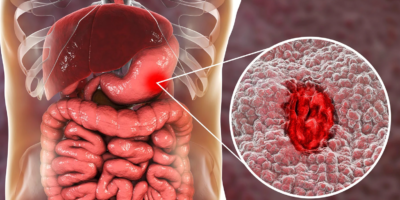Nausea and vomiting are common and stem from multiple causes. Like diarrhea, vomiting represents a nonspecific defense to rid the body of noxious substances. Culprits include alcohol intoxication, injudicious eating, food allergies and intolerances, food poisoning, microbes that infect the gastrointestinal tract, and chemotherapy. Sometimes there isn’t anything nasty to expel. Take, for example, motion sickness and morning sickness in pregnancy. Migraine headaches can produce nausea, and the headache may subside after a bout of vomiting. Regardless of the cause, the symptoms are certainly unpleasant.


1. Rice Water
How it works: This traditional Asian remedy can help replace the water, sugars, and salts your body has lost. Ginger is the best-researched antinausea agent.
- PREPARATION:
- 3 cups (710 ml) water
- ¹∕8 teaspoons (0.75 g) salt
- ¼ cup (49 g) uncooked white rice
- 1 tablespoon (9 g) raisins
- 1 teaspoon (3 g) grated fresh ginger
- Honey, to taste
- DIRECTIONS: In a medium-size saucepan, combine water, salt, and rice. Bring to a boil. Lower the heat. Stir in the raisins and ginger, and then cover. Cook over low heat for an hour. Pour through a strainer into a mug. Set aside the rice and raisins for when you’re keeping down clear liquids. Allow the rice water to cool. Add honey or salt as desired, and sip.
- YIELD: 01 SERVING
- NOTE: For a nutritious soup, add ½ cup (120 ml) vegetable or chicken stock to the rice water and ½ cup (93 g) of the strained rice.
2. Congee
How it works: This soft rice is easy to digest and returns water and salt to the depleted system.
- PREPARATION:
- 1½ quarts (1.4 L) water
- 1 cup (185 g) uncooked long-grain white rice
- 1 teaspoon (6 g) salt
- DIRECTIONS: In a large pot, mix the water and rice. Bring the mixture to a boil. Cover, tilting the lid to release steam. Lower the heat to its lowest setting. Cook for 4 hours, stirring occasionally until the rice is very soft and creamy. Stir in the salt.
- YIELD: MULTIPLE SERVINGS, DEPENDING ON SIZE. EAT A LITTLE AT A TIME, AS THE STOMACH ALLOWS.
3. Soup-er Broth
How it works: Bouillon broth returns salt and other nutrients to the depleted system. Ginger and cinnamon can also help settle the stomach.
- PREPARATION:
- 2 cups (475 ml) water
- 2 chicken bouillon cubes
- 2 teaspoons (4 g) minced fresh ginger
- Pinch of ground cinnamon
- DIRECTIONS: In a small saucepan, boil the water with the bouillon cubes, stirring until dissolved. Add the ginger and cook over low heat for 30 minutes. Strain out the ginger. Serve with a pinch of cinnamon.
- YIELD: 02 SERVINGS
4. Zingy Minty Nausea Fighter
How it works: The prime antinausea agent ginger combines with mint, which also reduces nausea and generally helps settle the stomach.
- PREPARATION:
- 2 cups (475 ml) water
- 2 teaspoons (1 g) dried peppermint or spearmint leaves, or 1 tablespoon (6 g) fresh
- 1 teaspoon (3 g) grated fresh ginger, or
- ½ teaspoon dried
- 1 teaspoon (7 g) honey
- DIRECTIONS: In a saucepan, bring the water to a boil. Add peppermint and ginger. Turn off the heat, cover, and steep for 15 minutes. Strain out the herbs. Stir in the honey. Sip frequently.
- YIELD: 02 SERVINGS
- WARNING: Do not give honey to children under twelve months of age. Use molasses, pure maple syrup, or raw sugar instead.
- NOTE: Alternatively, use tea bags instead of fresh leaves. Also, you can double the recipe and set it aside to sip continuously throughout the day.
5. Stomach-Settling Tea
How it works: Ginger combats nausea. Anise and cardamom reduce intestinal spasms if your nausea is accompanied by diarrhea.
- PREPARATION:
- 2 cups (475 ml) water
- 1 teaspoon (2 g) dried ginger, or 2 teaspoons (5 g) grated fresh
- ¾ teaspoon aniseeds
- ¼ teaspoon ground cardamom
- Honey
- DIRECTIONS: In a small saucepan, bring water to a boil. Turn heat to low. Add spices and stir. Simmer for 5 minutes. Cover and steep for 20 minutes. Strain. Add honey, if desired. Sip slowly.
- YIELD: 02 SERVINGS
6. Rehydrate and Restore
How it works: Starch, sugar, sodium, and potassium return vital nutrients to the body after depletion by vomiting, diarrhea, or other loss of fluids. They also help the body retain essential fluids and salts when another episode takes place.
- PREPARATION:
- 1 level teaspoon (6 g) salt
- 8 level teaspoons (22 g) sugar
- 5 cups (1.2 L) of clean water (If unsure, boil and then cool.)
- ½ cup (120 ml) orange juice, or ¼ cup (56 g) mashed banana
- DIRECTIONS: Starch, sugar, sodium, and potassium return vital nutrients to the body after depletion by vomiting, diarrhea, or other loss of fluids. They also help the body retain essential fluids and salts when another episode takes place.
- YIELD: MULTIPLE APPLICATIONS
- NOTE: Store in a cool place. This solution is good for about twenty-four hours. After that time, prepare a fresh one. Take additional liquids to help restore hydration.
7. Cool Head Luke
How it works: No one knows why a cool pack makes you feel better if you’ve been vomiting. It just seems to work for some people.
- PREPARATION: 6 ice cubes
- DIRECTIONS: Fill a sandwich-size resealable plastic bag with ice cubes. Wrap in a clean towel or T-shirt. Lie down in a quiet place. Apply the pack to your forehead, temples, or the back of your neck.
- YIELD: 01 APPLICATION
8. Stomach-Soothing Scent
How it works: Studies show that inhaling essential oils of peppermint, spearmint, or ginger can reduce nausea and vomiting. In a 2012 study of pregnant women needing C-sections, inhaling peppermint essential oil reduced postoperative nausea. A 2013 study found that spearmint and peppermint essential oils (combined with standard antinausea medications) significantly reduced nausea and vomiting in cancer patients receiving chemotherapy. The volunteers received capsules containing only sugar, sugar plus 2 drops of peppermint essential oil, or sugar plus 2 drops of spearmint essential oil.
- PREPARATION: 2 to 3 drops peppermint essential oil
- DIRECTIONS: Drop the essential oil onto a clean, cold washcloth, and then place on your forehead as you lie prone. Close your eyes and breathe in the scent.
- YIELD: 01 APPLICATION
- NOTE: Alternatively: Ideally, you should get a diffuser for essential oils, available in a health food store or online. Some are inexpensive; others may cost fifty dollars and up. Also, if you have a collection of plant essential oils, feel free to choose any scent that makes you feel less queasy.
9. Soothing Stomach Rub
How it works: The pleasant scent helps calm nausea. The massaging motion is soothing and imparts the antinausea effects of ginger and peppermint. German chamomile adds an antispasmodic effect to reduce cramping. The essential oils can cross the skin into your bloodstream and provide benefits as you inhale the aromas.
- PREPARATION:
- 2 tablespoons (30 ml) olive or other carrier oil
- 6 drops German chamomile essential oil
- 2 drops ginger essential oil
- 4 drops peppermint essential oil
- DIRECTIONS: Combine all the ingredients in a clean jar. Cap and shake. Gently massage a small amount into your belly.
- YIELD: 01 APPLICATION
Fact or Myth?
- CHEMOTHERAPY ALWAYS CAUSES NAUSEA AND VOMITING. Myth. Although nausea may occur—depending on the type of chemo patients receive — premedication for cancer patients includes many antinausea drugs that have been found to be effective.
- NAUSEA AND VOMITING GO ALONG WITH THE FLU. Myth: Some people refer to nausea, vomiting, and diarrhea of infectious gastroenteritis (inflammation of the stomach and intestines) as “stomach flu.” However, influenza viruses, which cause flu, infect the respiratory system and only rarely affect the gut. Different viruses, as well as bacteria and protozoa, cause infectious gastroenteritis.
Lifestyle Tip
- Breathe and visualize. Close your eyes and breathe slowly in and out, imagining yourself well and thriving and back on top of the world.
- Chew away your nausea. Pop a few seeds of anise or fennel into your mouth. Or chew a fresh basil leaf (spit into a saucer after chewing.) All these herbs freshen your mouth and reduce queasiness.
- Suck a peppermint. It has a cooling sensation on the stomach and can help calm nausea.
- When traveling:
- Before you take a car, boat, plane, or bus trip, eat a small amount of starch — toast or saltines are a good bet.
- If you’re in a car or bus, it helps to sit in the front seat and keep the window open. Look straight ahead, not out to the sides as the scenery whooshes by.
- If you’re in a plane, make sure the vent air is blowing directly on you to keep you cooled down.
- On a boat, stay on deck. If you have to go below, stay in the middle of the boat where it’s most stable.
When to call the doctor
- Vomiting hasn’t stopped within 12 hours.
- Eight hours after symptoms begin, you (or your child) cannot keep down any fluids.
- Signs of dehydration occur dry lips and mouth, crying without tears, no urination within 8 hours, or sunken eyes. (Small children can become easily dehydrated.)
- You develop a fever higher than 103°F (39.4°C).
- You vomit blood. (Old blood can resemble coffee grounds.)
- You have severe pain.
- You experience cyclic episodes of nausea and vomiting.
- Persistent vertigo accompanies nausea and vomiting.
- You have recurrent episodes of severe head or eye pain with nausea and vomiting.
- You’ve had a head injury and have vomited more than once.
- Nausea and vomiting coincide with the start of a new medication.
- You frequently have a burning sensation behind your breastbone.
- Severe anxiety precedes nausea and vomiting.
- You have a serious chronic condition, such as diabetes, liver disease, or kidney disease.






Leave a Reply